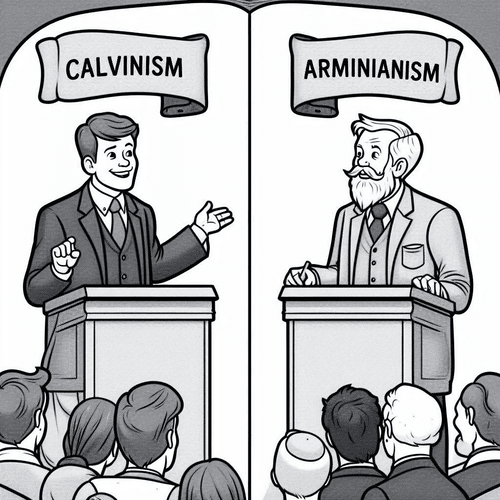Sequence of End-Time Events: What Do We Expect First?
Amidst the conflicting end-time theories, Christians often struggle to make sense of biblical prophecy. Terms such as “apostasia,” “the Restrainer,” and “the man of lawlessness” appear in Scripture, but their meanings and sequence are frequently misunderstood, even misinterpreted. The confusion isn’t new—even the early church needed clarification, which is why Paul wrote passages like 2 Thessalonians 2:1-8.
Let’s examine not only what these prophetic terms actually mean from a Reformed perspective but also establish a biblical timeline of events that will precede Christ’s return.
KEY BIBLICAL TERMS DEFINED
Apostasia: This Greek word appears in 2 Thessalonians 2:3, where Paul writes: “Let no one deceive you in any way. For that day will not come, unless the rebellion [apostasia] comes first, and the man of lawlessness is revealed, the son of destruction.”
In Reformed theology, the term refers to a great falling away or rebellion against God and His truth. It describes a significant departure from genuine faith—not merely external conflict, but internal corruption within the visible church. John Calvin understood this as “a general revolt of the visible Church” against sound doctrine. Throughout church history, Reformed theologians have consistently interpreted this as a widespread abandonment of biblical truth.
Importantly, “apostasia” is never used in Scripture to describe a physical removal or departure (as in a rapture) but always a defection from truth or rebellion against authority. The term appears elsewhere in Acts 21:21, where Paul is accused of teaching Jews to “forsake” (apostasia from) Moses.
The Restrainer/Restraining: In 2 Thessalonians 2:6-7, Paul mentions something or someone that is currently restraining the full manifestation of lawlessness: “And you know what is restraining him now so that he may be revealed in his time. For the mystery of lawlessness is already at work. Only he who now restrains it will do so until he is out of the way.”
Reformed interpretations of the Restrainer typically include:
- The Holy Spirit: Working through the church (the most common view)
- Human government and law that prevents complete anarchy
- Divine providence limiting Satan’s freedom until God’s appointed time
Reformed theology emphasises God’s sovereignty in this restraining work—whatever its precise nature. It serves God’s purposes in His redemptive timeline.
Man of Lawlessness: This figure described in 2 Thessalonians 2:3-4 represents the culmination of opposition to God:
“The man of lawlessness is revealed, the son of destruction, who opposes and exalts himself against every so-called god or object of worship, so that he takes his seat in the temple of God, proclaiming himself to be God.”
Reformed theology has historically identified this figure as the Antichrist—not merely a political leader, but the embodiment of religious deception that arises from within the church itself. While some Reformed thinkers (particularly during the Reformation) identified this with the papacy, most contemporary Reformed scholars see it as a still-future figure representing the ultimate expression of human rebellion against God.
Abomination of Desolation: Jesus referenced this term from Daniel in Matthew 24:15: “So when you see the abomination of desolation spoken of by the prophet Daniel, standing in the holy place (let the reader understand)…”
In Reformed understanding, this represents the ultimate desecration of what is sacred—idolatry in its most blasphemous form. While it had a historical fulfillment in Antiochus Epiphanes (167 BC) and possibly the Roman destruction of Jerusalem (70 AD), many Reformed scholars see a final fulfillment connected with the Man of Lawlessness, who will attempt to replace worship of the true God with worship of himself.
Day of the Lord: This term describes the culmination of history when Christ returns in judgement and redemption. In Reformed theology, this is understood as a single event—Christ’s return—rather than being divided into multiple comings. It will bring both judgement for unbelievers and final redemption for God’s people.
THE BIBLICAL SEQUENCE OF EVENTS
Based on 2 Thessalonians 2:1-8 and related passages, the Reformed understanding of the sequence includes:
- The age when the Restrainer continues to limit lawlessness
- The Apostasia (falling away) occurs—a widespread rebellion against biblical truth
- The Restrainer is removed or steps aside according to God’s timing
- The Man of Lawlessness is revealed and exalts himself above God
- The Abomination of Desolation takes place as the culmination of blasphemy
- The Day of the Lord arrives with Christ’s visible, bodily return
APOSTASIA IS NOT THE RAPTURE
Some modern teachers have attempted to reinterpret “apostasia” as referring to the rapture or physical departure of the church. This interpretation is problematic for several reasons:
- Linguistic evidence: Throughout the New Testament and other Greek literature, “apostasia” consistently refers to rebellion or defection, never to physical removal.
- Biblical context: The flow of Paul’s argument in 2 Thessalonians 2 makes more sense when understood as warning about spiritual defection rather than describing the church’s removal.
- Historical interpretation: No major theologian prior to the 19th century interpreted “apostasia” as a physical rapture. This novel interpretation arose alongside dispensationalism in the 1800s.
- Reformed theology: A pre-tribulation rapture concept is inconsistent with the historic Reformed understanding of God’s covenant promises and the unity of God’s people.
The Greek word that actually does refer to being “caught up” is harpazo (found in 1 Thessalonians 4:17), not “apostasia.”
PRACTICAL IMPLICATIONS FOR BELIEVERS TODAY
Understanding these events from a Reformed perspective leads to several important applications:
- Be watchful without obsession: Jesus called us to discern the signs of the times, but not to engage in date-setting or unhealthy speculation.
- Expect increasing apostasy. Scripture warns that many will fall away from the faith. This should motivate us to hold fast to sound doctrine and strengthen our fellow believers.
- Trust God’s sovereignty. The restraining work, the apostasy, and even the man of lawlessness all operate within God’s perfect plan and timing.
- Focus on faithful ministry. Rather than being paralyzed by fear or distracted by endless end-times theories, we should focus on the Great Commission and living faithfully for Christ.
CONCLUSION: SEQUENCE OF END-TIME EVENTS
Reformed theology provides a balanced framework for understanding prophecy that avoids both sensationalism and scepticism. The apostasia and restraining are real biblical concepts that remind us of the serious spiritual battle underway—one that will intensify before Christ’s return.
Rather than being caught up in the latest end-times speculation or reinterpreting Scripture to fit contemporary events, we should hold fast to the historic Christian faith, trust in God’s sovereign timing, and live with hopeful expectation of Christ’s certain return.
Until that day, we’re called to faithful witness and perseverance, knowing “the one who endures to the end will be saved” (Matthew 24:13).
SEQUENCE OF END-TIME EVENTS: RELATED FAQs
Has the apostasia already begun, or is it entirely future? Reformed theologians generally see the apostasia as having both present and future dimensions. While there have been periods of significant doctrinal departure throughout church history, most scholars anticipate a more pronounced, widespread falling away immediately preceding Christ’s return. This aligns with Jesus’s warning in Matthew 24:12: “the love of many will grow cold” in the last days.
- Could the restrainer be the church rather than the Holy Spirit? Some Reformed thinkers make a distinction between the Holy Spirit’s omnipresence and His restraining ministry through the church. Since Scripture promises the Holy Spirit will never leave believers (John 14:16), this view holds it’s unlikely it is the Spirit Himself who is removed, but rather His specific restraining influence through the church’s witness and moral impact on society. The church serves as “salt and light” (Matthew 5:13-14), and its diminished influence could correspond with the removal of restraint.
- How does Reformed eschatology view the millennium in Revelation 20? Most Reformed theologians hold either an amillennial view (the millennium represents the present church age symbolically) or a postmillennial view (the millennium represents a future golden age of Christian influence before Christ’s return). Unlike dispensationalism, Reformed theology typically rejects a literal 1,000-year physical reign of Christ after a rapture. The focus remains on Christ’s single, glorious return that ushers in the eternal state.
Do Reformed theologians connect the apostasia with specific moral issues in modern society? While Reformed theology recognises moral decline as a sign of spiritual apostasy, it emphasises the core of apostasia is theological rather than merely moral. The primary concern is abandonment of biblical truth and sound doctrine, particularly regarding the person and work of Christ. Moral decline is viewed as a symptom of deeper theological apostasy rather than its essence.
- How should Christians respond to those who claim to identify the Man of Lawlessness among current world leaders? Reformed theology urges caution against hastily identifying specific individuals as the Man of Lawlessness. Throughout history, many figures have been wrongly labelled as the Antichrist, which has led to both failed predictions and uncharitable judgements. Instead, Christians should focus on the biblical descriptions of this figure’s character and work, remaining watchful without making premature identifications.
- What is the relationship between the apostasia and false teaching within the church? False teaching is both a catalyst for and expression of the apostasia. When churches compromise on essential doctrines or accommodate unbiblical worldviews, they create environments where sequenceapostasy flourishes. The antidote to apostasy remains steadfast commitment to biblical authority, sound doctrine, and faithful preaching of the gospel.
Does the concept of the restrainer suggest Christians should be politically engaged to maintain societal order? Many thinkers affirm Christians have civic responsibilities that include promoting justice and order in society. However, they warn against equating political activism with the advancement of God’s kingdom. While governance serves God’s restraining purposes in this age, the ultimate hope for Christians lies not in political solutions but in Christ’s return and the establishment of His perfect kingdom.
SEQUENCE OF END-TIME EVENTS: OUR RELATED POSTS
Editor's Pick

GPS Without Eyes: How Ants Silently Shout Intelligent Design
Picture a leafcutter ant navigating the rainforest floor in pitch darkness, carrying a leaf fragment 50 times its body weight. [...]

Born Broken: Why Must We Affirm Original Sin?
Imagine a world where we’re born neutral—free to choose good, and without a bias toward evil. Sounds appealing… until we [...]

Does God Truly Care About My Everyday Choices?
OWe believe God created the universe. We believe He orchestrated the exodus from Egypt and raised Jesus from the dead. [...]
SUPPORT US:
Feel the Holy Spirit's gentle nudge to partner with us?
Donate Online:
Account Name: TRUTHS TO DIE FOR FOUNDATION
Account Number: 10243565459
Bank IFSC: IDFB0043391
Bank Name: IDFC FIRST BANK






